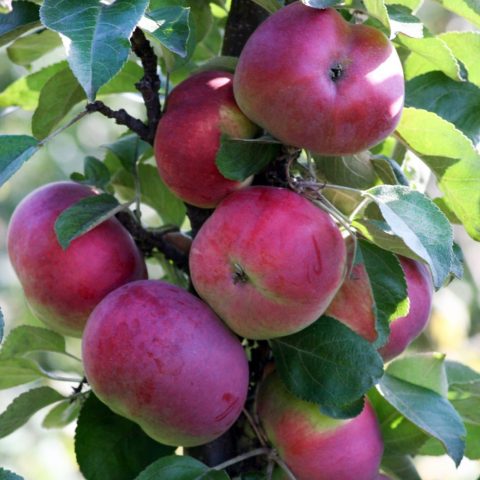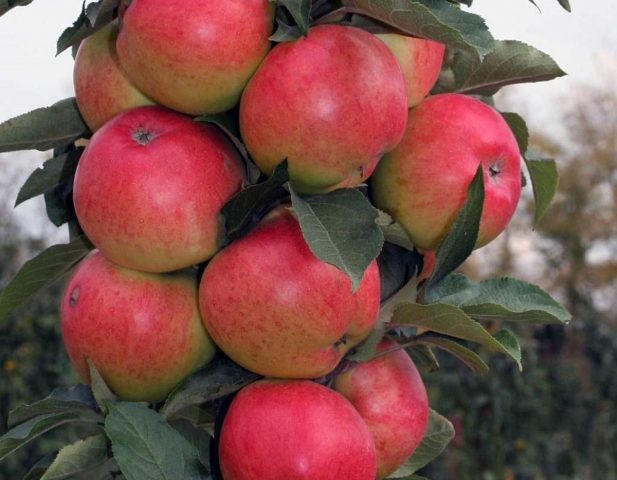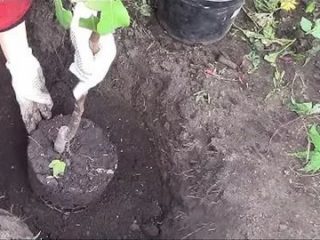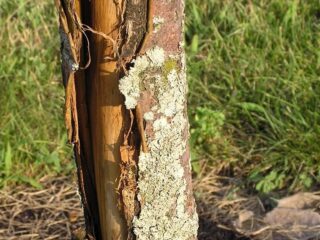Content
Thanks to selection, it has become possible to successfully grow apple trees and obtain a stable harvest even in regions with difficult climatic conditions. After all, new types of crops have increased resistance to temperature changes and frost. Therefore, both the standard type and the columnar apple tree are now found everywhere in the Urals. The latter is characterized by a compact crown size, which makes it possible to grow a fruit tree even in small garden plots.

Columnar apple trees are characterized by early fruiting
The best varieties of columnar apple trees for the Urals
The climate of the Urals is sharply continental. However, the length of the mountain range is more than 2.5 thousand km, which has a significant impact on the weather conditions of different parts of the region. Therefore, when purchasing an apple tree, you need to take into account the possibility of growing it in the southern, middle and northern Urals.Since not all types of crops can be successfully grown in different climatic zones of the region.
Columnar apple tree for the southern Urals
The climate of the southern Urals is characterized by frosty winters, which last from mid-November to March with sharp temperature changes. During the cold period, sunny days predominate, and there are snowstorms and snowstorms, especially in February. Spring is cool with frosts, sleet, and a constant alternation of sunny and cloudy days. Summer in the southern part of the Urals with heavy rains and temperatures from +19 to 34 °C. And autumn is cold, mostly cloudy, with strong winds.
Recommended varieties of columnar apple trees for the southern Urals, taking into account the climate characteristics of this part of the region:
- Chervonets. This hybrid was included in the State Register in 2008. The Chervonets apple tree is a semi-dwarf, its height barely reaches 2 m. It begins to bear fruit 2-3 years after planting. The tree's productivity level is 6-8 kg. The apples are large, weighing about 180g. The tree retains a high life potential for 15-17 years. Chervonets is an autumn species of columnar apple tree. The harvest tolerates transportation and storage well for 2-3 months.
Chervonets apple tree is resistant to scab
- Waltz. The variety is summer. The harvest ripens at the end of August. The height of the tree is 2.5-3 m. The apples are medium-sized, round in shape. The shade of the fruit is light green, the cover is in the form of red strokes on most of the surface. The high life potential of the tree remains for 15 years. The harvest is suitable for fresh consumption and processing.
Columnar apple tree Waltz is characterized by an accelerated growth rate
- Dialogue. This is an early ripening variety of columnar apple tree, which is excellent for the southern Urals. The fruiting period begins in late July-early August. With standard care, the tree's yield reaches 5-6 kg. The height of the Dialog apple tree is 2.5 m. The crown is dense and compact. The tree can withstand temperatures down to -40 °C.
The Dialog apple tree harvest retains its consumer properties for one month
For the middle Urals
The climate of the Middle Urals is continental and is characterized by sharp changes in weather conditions not only within a few days, but also within a day. Winter in this part of the region lasts for five months, namely from November to April. Moreover, from the beginning of the cold period, stable snow cover appears. Spring in the Middle Urals is characterized by regular frosts that continue until the end of May. Summer is mostly rainy, cool, dry weather sets in only in July. In autumn, drizzling rain and cloudiness are not uncommon.
Recommended varieties of columnar apple trees for the Middle Urals, taking into account the climate:
- Amber necklace. A late-ripening apple variety that is suitable for long-term storage. The height of the tree reaches 2 m. The yield level is 5-7 kg. Harvesting the fruits is recommended at the end of September, but they acquire a balanced taste after a month of storage. The color of the fruit is greenish-yellow. The pulp is white, juicy, sweet with a small amount of sourness.
The Amber Necklace apple tree begins to bear fruit in the second year after planting
- Iksha. The variety has not yet been included in the State Register of Russia, but has already gained wide popularity due to its hardiness and excellent quality of the fruit.The tree grows up to 2.2-2.5 m. The shoots are thickened, attached at an acute angle to the trunk. Crown of medium foliage. The variety belongs to the early autumn category. The harvest can be harvested in early September. The fruits are flat-round and medium in size. The color is yellow, but the outer skin in the form of red stripes occupies most of the surface.
The tasting rating of the columnar apple tree Iksha is 4.5 points
- Nectar. Autumn self-fertile variety. It is highly resistant to diseases and frost. The fruits are yellow in color, weighing 120-250 g. The yield is 9-15 kg, depending on care. The taste of the fruit is sweet, with a honey aroma and aftertaste. The shelf life of the harvest is one month.
The columnar Medoc apple tree is capable of forming an ovary in the year of planting
For the northern Urals
The Northern Urals have a harsh continental climate. In this part of the region, winters are harsh and long, and summers are short and cool. Also, spring is much longer than autumn. Therefore, for the northern part of the Urals, it is necessary to choose varieties whose harvest can ripen even with a minimum number of sunny days during the season.
Suitable types of columnar apple trees:
- Ranet Mazherova. The height of the tree barely reaches 2 m, and the width of the crown is only 40 cm. It begins to bear fruit in the third year after planting. The apples are small, up to 80 g, round in shape, yellow in color. The harvest is suitable for fresh consumption and processing. The pulp is creamy, juicy, sweet and sour. Harvesting is recommended in early September.
Ranet Mazherova can withstand frosts down to -45 degrees
- Ostankino. High-yielding self-sterile variety. The height of the tree reaches 2.5 m. The fruits are round, slightly flattened, weighing 150-200 g. The color is greenish-yellow with a purple-red blush.The pulp is white, fine-grained, with a dessert taste. The variety is considered an autumn variety; harvesting is recommended at the end of September.
The Ostankino harvest lasts well until December
- Arbat. This is one of the first columnar apple varieties. Characterized by unpretentiousness and stable fruiting. Tree height 2.5 m. Apple tree yield 12 kg. The fruits are medium-sized, weighing 85-100 g. The apples are flat-round with slight ribbing at the top. The tasting rating of the variety is 3.8 points out of a possible five.
In the fruits of the Arbat variety, the content of ascorbic acid reaches 4.5-6.4 mg per 100 g
How to plant columnar apple trees in spring in the Urals
How correctly the apple tree is planted directly determines its further development and level of productivity. Therefore, it is recommended that you familiarize yourself with the specifics of this procedure in advance.
Selection of seedlings
When purchasing seedlings, you need to carefully examine their appearance. Young apple trees should have a well-developed root system, and there should be no signs of mechanical damage or disease on the trunk. Also, the underground part of the plants should not have swellings or thickenings. The roots of a healthy tree bend well and have a light shade when cut.
One- and two-year-old seedlings are suitable for planting, which guarantees their rapid adaptation to a new location.
Landing dates
It is recommended to plant a tree in the Urals in the spring before the growing season begins.In this case, the columnar apple tree will be able to fully take root and strengthen before the arrival of the cold period. Planting a columnar apple tree in the fall in the Urals is also possible if done in advance. In this case, the procedure must be carried out in September, namely in the middle of the month. But it is recommended to plant a columnar apple tree in the fall in the Urals only as a last resort, since the probability of the seedling freezing in the first winter is very high.
Selecting a location
To plant a columnar apple tree in the Urals, it is recommended to choose a sunny area that is well lit throughout the day. The best option is the southern or southwestern part of the garden. It is important that the place is protected from cold gusts of wind. Therefore, it is allowed to plant an apple tree near a fence or buildings at a distance of 2 m, if they do not form a shadow for it.
The columnar variety, like conventional types of crops, prefers loose, nutritious soil with a neutral acidity level. Therefore, loams are well suited for it. In this case, groundwater on the site should be located 1.5-2 m below the soil surface.
Landing technology
To plant a columnar apple tree in the Urals, you need to prepare a hole measuring 80 by 80 cm. This must be done at least two weeks in advance, or better yet, in the fall. A layer of drainage 10 cm thick must be placed at the bottom of the planting hole, which will prevent constant contact of the roots of the seedling with moisture even in prolonged rainy weather. The remaining volume of the hole must be filled with a nutrient substrate consisting of turf, humus, peat, sand in a ratio of 2:1:1:1.Additionally, 40 g of superphosphate and 25 g of potassium sulfide should be poured into the recess, and then the fertilizers should be thoroughly mixed with the soil.

A day before planting, the seedling must be placed in water to nourish the roots.
Algorithm of actions:
- Make a slight elevation in the center of the hole.
- Place a wooden support 1.2-1.5 m high next to it.
- Place the apple tree on a raised platform and carefully straighten the root shoots.
- Water generously and wait until the moisture is completely absorbed.
- Sprinkle the roots with soil and fill all the voids.
- Compact the soil at the base of the seedling.
- Tie it to the support with elastic twine.
Caring for a columnar apple tree in the Urals
This fruit tree does not require complex care, but following simple rules of agricultural technology allows you to accelerate the rate of its development and fruiting. Therefore, you need to familiarize yourself with them in advance.
Watering
In the conditions of the Urals, it is necessary to water the columnar apple tree rarely, only during a long absence of precipitation. Moisturize in the root circle, wetting the soil up to 10 cm. Regular watering once a week.
Feeding
To maintain the high productivity of columnar apple trees in the Urals, it is necessary to fertilize them in a timely manner, taking into account the stage of tree development. Therefore, it is recommended to apply fertilizers for the first time in early spring before the beginning of the growing season. During this period, you can use ammonium nitrate or urea at the rate of 30-80 g. The second and third feedings are recommended after flowering and at the stage of ovary formation. At this time, you can use superphosphate 40-100 g and potassium sulfate 25-60 g.
It is recommended to apply fertilizers to the root circle of the tree and then incorporate them into the soil. You can feed the columnar apple tree after rain or watering to avoid burns to the roots.
Trimming and shaping
To maintain the high vital potential of a young seedling, it is necessary to normalize the load. Therefore, in the year of planting, it is recommended to remove all the buds on the apple tree, and leave no more than five for the second season. In the future, in order for the tree to bear large fruits, it is recommended to leave up to three ovaries on one branch.
When growing columnar apple trees in the Urals, it is important to correctly form the crown. It should be understood that there should only be one barrel. If 2-4 shoots appear, it is recommended to isolate the strongest one and completely remove the rest.
In the first season after planting, you need to shorten the side branches to two buds. And in the second and third years, carry out similar pruning on new shoots that have appeared. In the future, as the apple tree matures, it is recommended to remove branches from below that are older than five years, which gradually lose their potential.

Pruning should be done in the spring before active sap flow begins.
Preparing for winter
When growing a columnar apple tree in the Urals, the tree must be insulated for the winter. To do this in the fall, it is recommended to lay a 10 cm thick layer of humus in the root circle. It is also necessary to wrap the crown of the apple tree with agrofibre in several layers and secure the protective layer so that it does not blow away by the wind.
Throughout the winter, it is recommended to cover the tree with snow if necessary, which will allow it to withstand severe frosts without much difficulty.
Diseases and pests
Columnar apple trees are characterized by increased immunity to scab and other common crop diseases. They are also less susceptible to pests. But to maintain high tree resistance, it is recommended to carry out preventive treatments in spring and autumn with Bordeaux mixture or copper sulfate.
Conclusion
The columnar apple tree in the Urals is becoming more and more popular every year. After all, this species is able to grow even in a small area and regularly bear fruit. Moreover, the tree does not require maintenance; you just need to adhere to standard rules of agricultural technology and promptly update it when productivity decreases.
Reviews of columnar apple trees in the Urals

















